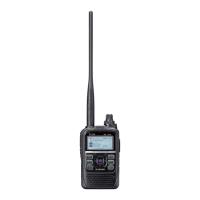1
REPEATER AND DUPLEX OPERATIONS
1
2
3
4
5
6
7
8
9
10
11
12
13
14
15
16
17
18
19
20
21
1-7
■ 1750 Hz tone
To access most European repeaters, the transceiver
must transmit a 1750 Hz tone. For such European re-
peaters, perform the following.
• This tone can also be used as a ‘Call signal.’
For only the ID-31E:
Push [PTT] briefly, then hold down [PTT] to transmit
a 1750 Hz tone burst signal.
Push D-pad( q ) to select the root item (“DTMF/T-
CALL”), and then push D-pad(Ent).
Push D-pad( w ) to select “DTMF Memory,” and then
push D-pad(Ent).
Rotate [DIAL] to select “T-CALL,” and then push e
D-pad(Ent) to set.
Push [MENU] r
to exit the MENU screen.
Rotate [DIAL] to set the receive frequency (repeater t
output frequency).
Set the duplex offset direction. (p. 1-5) y
• “DUP–” or “DUP+” appears.
While holding down [PTT], push [SQL] to transmit a u
1750 Hz tone signal.
• If “OFF BAND” appears, check the offset frequency or
shift direction. (pp. 1-4, 1-5)
• While transmitting, the displayed frequency automati-
cally changes to the transmit frequency (repeater input
frequency).
Hold down [SQL] to check whether the other sta- i
tion’s transmit signal can be received directly or not,
by listening on the repeater input frequency.
• While monitoring, the TX/RX indicator lights green, and
the S/RF meter dot blinks.
• While monitoring, the displayed frequency automatically
changes to the transmit frequency (repeater input fre-
quency).
• If you can hear the other station, you may want to change
to the Simplex mode and contact directly.
Push [PTT] to transmit. o
!0 Release [PTT] to receive.
[DIAL]
[PTT]
[SQL]

